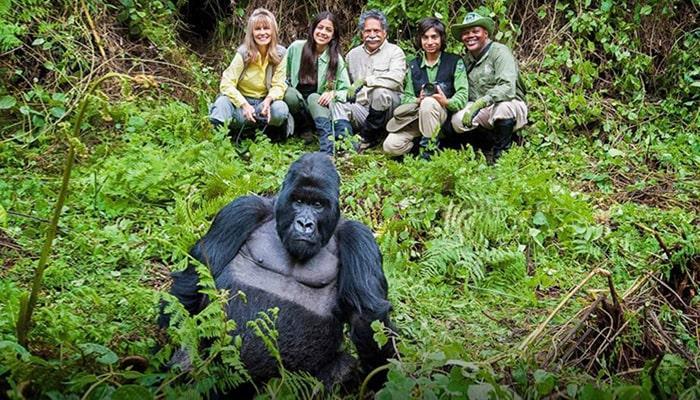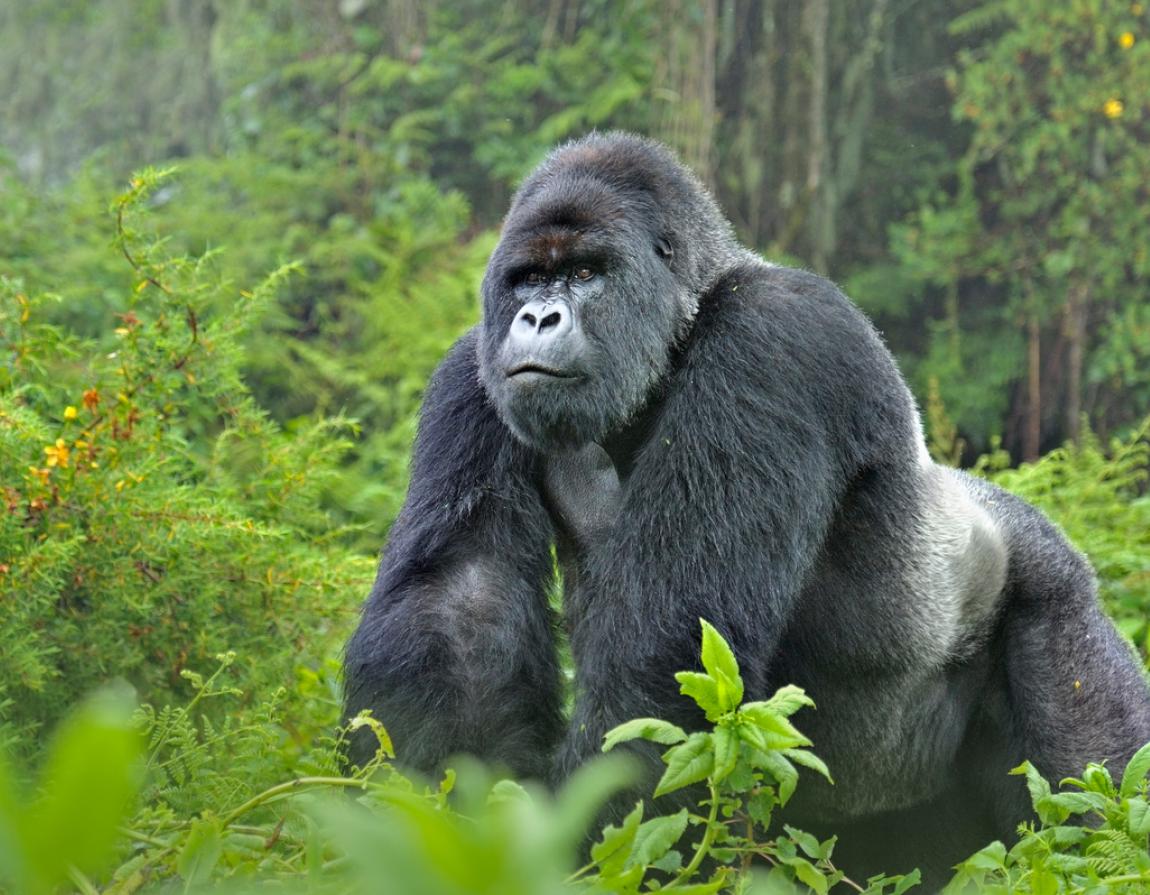Interesting Things about Mountain Gorillas: The jeopardized Mountain Gorillas of Uganda won’t be found in any kind of mood on the planet (they don’t get by in any kind of mood there are no enduring mountain gorillas in zoos). You can track down them and see them in Africa, in the nations of Uganda, Rwanda, and the Democratic Republic of Congo.
As per enumeration information delivered by the Uganda Wildlife Authority (November 2012), there are around 880 Mountain Gorillas left on the planet and more than 400 of those live in Bwindi Impenetrable Forest alone. Others can be found in Mgahinga Gorilla National Park in Uganda, Volcanoes National Park in Rwanda and Virunga National Park in the Democratic Republic of Congo.
The Mountain Gorillas were not known about by westerners until 1902. Rwanda was a German settlement when Captain von Berenge was getting over Mount Sabinyo on the Rwanda side for certain companions and they were at the 9300-foot level and set up camp when a gathering of Mountain Gorillas was spotted and he shot two of them however could recover one.
It was a youthful male around 5 years of age, 220 pounds and not excessively enormous, however bigger than any gorillas the German had seen. Bones and skin were shipped off Berlin where it was recognized as a gorilla.
Nobody had believed that gorillas could exist in such a high elevation and a lot colder environment than West Africa. The fresh insight about these gorillas attracted trackers to the region, particularly the Congo where they shot or caught Mountain Gorillas. Sovereign Wilhelm of Sweden shot 14 mountain gorillas in a 1920-1921 undertaking to the area.
The Belgians laid out a protections program for the Mountain Gorillas thus did the English in Uganda. In Uganda for quite a while, nobody was even permitted to take guests to see the Mountain Gorillas.
In Kisoro, Walter Baumgartel was allowed to set up visits for voyagers to his Travelers Rest Inn, a spot you can in any case remain at today in Uganda. Baumgartel composed the Book “Up among the Mountain Gorillas” which is about his time in Uganda and experiences with the goliath primates of southern Uganda.
It is an exquisite book about man, a motel, the excellence of the Ugandan open country, and generally about the Mountain Gorillas. Dian Fossey used to remain there consistently thus did George Schaller to name only two.
Most Gorillas that you could have experienced in a zoo are from the swamps of western Africa, the mountain gorillas are a subspecies called Gorilla beringei. The main spot you can observe them is in the wild in the Virunga areas of Rwanda in the Volcano Park of Rwanda, Virunga National Park in the Democratic Republic of Congo and in Uganda at Bwindi Impenetrable Forest National Park and Mgahinga Gorilla National Park.
The parks are inside 48 kilometers of one another. In Uganda and Rwanda, the parks are effortlessly gotten to, in the Democratic Republic of Congo there is the issue of renegade exercises and possibly perilous risk to guests because of the radical movement.
The Gorillas are really expanding in numbers because of the security they are getting from the Ugandan government which included the networks encompassing the parks and provides them with a part of the 500-dollar Gorilla following (traveling) expenses gathered from unfamiliar guests to Bwindi and Mgahinga.

Mountain Gorilla Description
The fur of the Mountain Gorilla, frequently thicker and longer than that of other gorilla species, empowers them to live in colder temperatures. Gorillas can be recognized by nose prints extraordinary to every person. Guys normally weigh two times as much as females, and this subspecies is on normal the biggest of all gorillas.
Grown-up guys have more articulated hard peaks on the top and back of their skulls, giving their heads a more tapered shape. These peaks anchor the strong masseter muscles, which append to the lower jaw. Grown-up females likewise have these peaks; however, they are less articulated.
Like all gorillas, they highlight dim earthy colored eyes outlined by a dark ring around the iris. Grown-up guys are called silverbacks on the grounds that a seat of dark or silver-shaded hair creates on their backs with age.
The hair on their backs is more limited than on most other body parts, and their arm hair is particularly lengthy. Completely erect, guys arrive at 1.9 m (6 ft 3 in) in level, with an arm range of 2.3 m (7 ft 7 in) and a load of 220 kg (490 lb).
The tallest silverback recorded was a 1.94 m (6 ft 4 in) individual shot in Alimbongo, northern Kivu in May 1938. There’s an unsubstantiated record of another individual, shot in 1932, that was 2.06 m (6 ft 9 in) tall. The heaviest was a 1.83 m (6 ft) silverback shot in Ambam, Cameroon which weighed around 266 kg (590 lb).
The Mountain Gorilla is essentially earthly and quadrupedal. Notwithstanding, it will move into fruiting trees in the event that the branches can convey its weight, and it is equipped for running bipedally up to 6 m (20 ft). The youthful ones will play in trees like kids.
Like generally incredible chimps other than people, its arms are longer than its legs. It moves by knuckle-strolling (like the Common Chimpanzee, yet in contrast to the Bonobo and both orangutan species), supporting its weight on the backs of its bended fingers as opposed to its palms.
 The Mountain Gorilla is diurnal, most dynamic between 6:00 a.m. also, 6:00 p.m. with a rest around noon. A considerable lot of these hours are spent eating. Enormous amounts of food are expected to support its gigantic mass. It rummages in the early morning, rests during the late morning and around noontime, and in the early evening it scrounges again prior to resting around evening time.
The Mountain Gorilla is diurnal, most dynamic between 6:00 a.m. also, 6:00 p.m. with a rest around noon. A considerable lot of these hours are spent eating. Enormous amounts of food are expected to support its gigantic mass. It rummages in the early morning, rests during the late morning and around noontime, and in the early evening it scrounges again prior to resting around evening time.Every gorilla fabricates a home from encompassing vegetation to snooze, building another one each evening. Just babies rest in similar home as their moms. They leave their dozing destinations when the sun ascends at around 6 am, aside from when it is cold.
The guys’ solidarity is multiple times more grounded than the hardest fighter, even on steroids. A silverback’s arms will loosen up seven feet. Mountain Gorillas have longer and hazier hair than their swamp cousins since they live in colder environments at a lot higher elevations.
Mountain Gorilla Life Cycle
Females become physically adult at 7-8 years of age, however don’t begin to raise until quite a while later. Guys mature later than females, with a couple of reproducing before the age of 15 years.
(By and large, just a single child is raised in a long-term period. Females by and large bring forth just three or four enduring youthful during their conceptive life.
The death rate for gorillas short of what one-year-old is high, yet for grown-ups, the rate is just 5%. In the wild, they could live 40 to 50 years of age. In the United States, a hostage gorilla was accounted for to have lived to the age of 54.
Mountain Gorilla Habitat and Diet
In Uganda there are two spots where Mountain Gorillas might be found, one is Mgahinga Gorilla Park. A lovely park and a piece of the Virunga chain of volcanoes that stretches into the Democratic Republic of Congo and Rwanda and Bwindi Impenetrable Forest National Park, running in height from 2,200-4,300 meters (7,200-14,100 ft).
The vegetation is exceptionally thick at the lower part of the mountains, becoming sparser at higher heights, and the timberlands where the Mountain Gorillas lives are in many cases overcast, foggy and cold. Mountain Gorillas are basically herbivores; most of their eating routine is made out of the leaves, shoots and stems (85.8%) of 142 plant species.
It likewise benefits from bark (6.9%), roots (3.3%), blossoms (2.3%), and organic product (1.7%), as well as little spineless creatures. (0.1%). Grown-up guys can eat as much as 34 kilograms (75 lb) of vegetation daily, while a female can eat as much as 18 kilograms (40 lb). Most mountain gorillas lay down for a little rest around noon.

Bwindi Impenetrable Forest contains the biggest Mountain Gorilla Population with more than 400 (November 2012). A primitive wood is likewise called “Spot of Darkness.” The overhang of the trees makes it dim inside the timberland. The elevations of the woods are between 1,160 to 2,607 meters above ocean level.
Bwindi and Mgahinga each have various attributes and similitudes. Bwindi is anything but a wiped-out volcanic region while Mgahinga is.
The home reach size (the region utilized by one gathering of gorillas during one year) is affected by the accessibility of food sources and for the most part incorporates a few vegetation zones. There are ten distinguished unmistakable zones, including: the bamboo woods at 2,200-2,800 meters (7,200-9,200 ft); the Hagenia backwoods at 2,800-3,400 meters (9,200-11,200 ft); and the goliath senecio zone at 3,400-4,300 meters (11,200-14,100 ft).
The Mountain Gorilla invests the greater part of its energy in the Hagenia timberlands, where gallium plants are tracked down all year. All pieces of this plant are consumed: leaves, stems, blossoms, and berries. It goes to the bamboo woods during the couple of months of the year new shoots are accessible, and it moves into subalpine areas to eat the delicate focuses of monster senecio trees.
They move day to day to an alternate area to go through the late evening making homes from twigs and leaves. A few people have tracked down them very agreeable, even to the point of nodding off in.
Mountain Gorilla Social Structure
In the Virunga Mountain Gorillas, the typical length of residency for a prevailing silverback is 4.7 years. 61% of gatherings are made out of one grown-up male and various females and 36% contain more than one grown-up male. The excess gorillas are either solitary guys or solely male gatherings, typically comprised of one mature male and a couple of more youthful guys. Bunch sizes differ from five to thirty, with a normal of ten people.
A normal gathering contains one silverback, who is the gathering’s undisputed chief; a couple blackbacks, who go about as guards; three to four physically mature females, who are usually clung to the predominant silverback forever; and from three to six adolescents and babies.



Comments